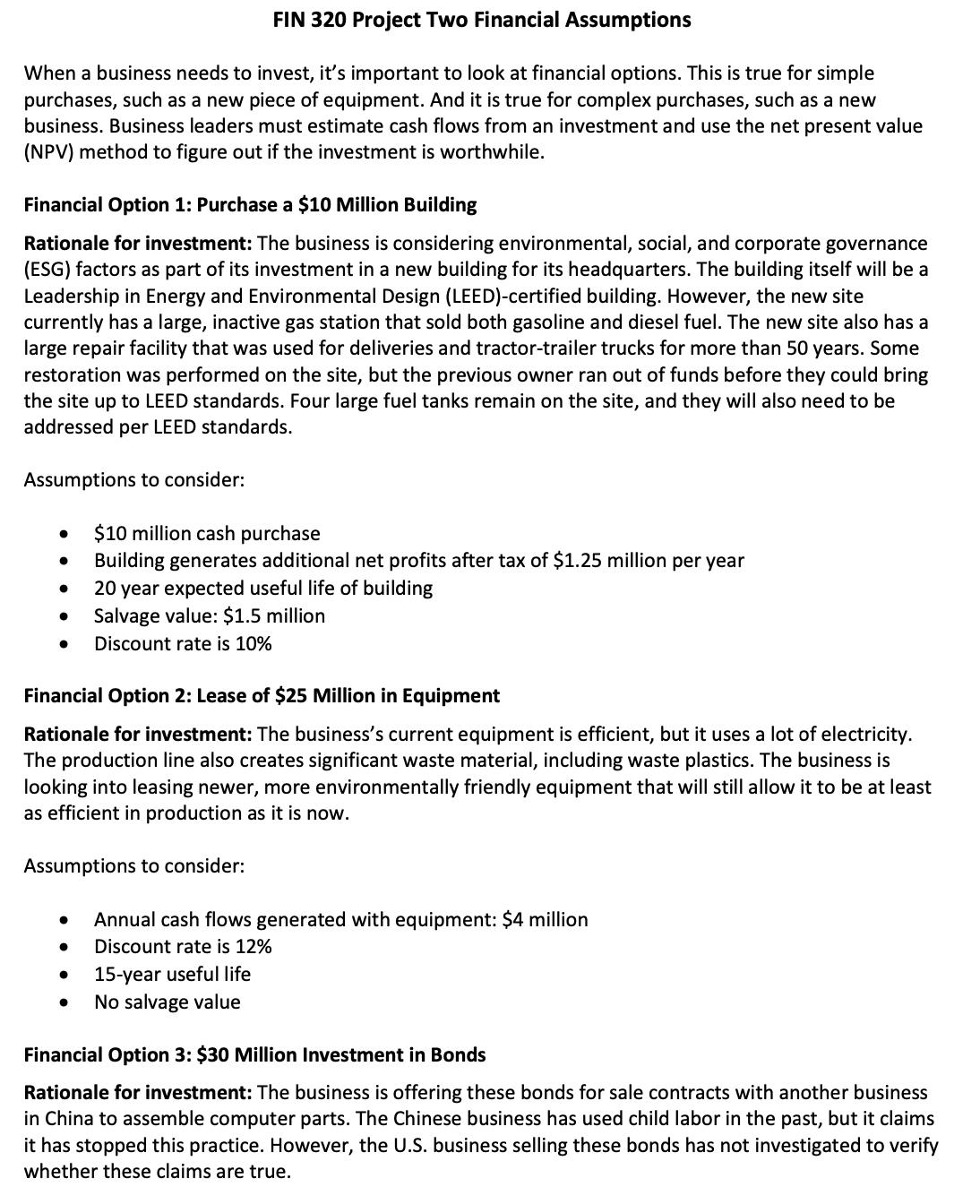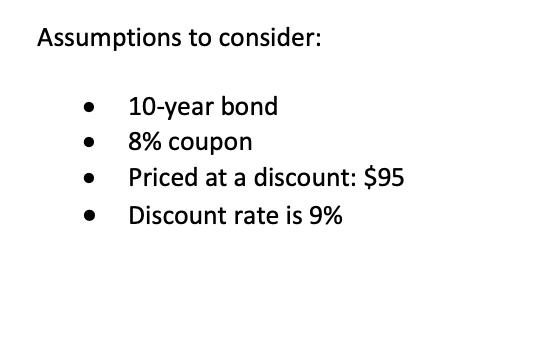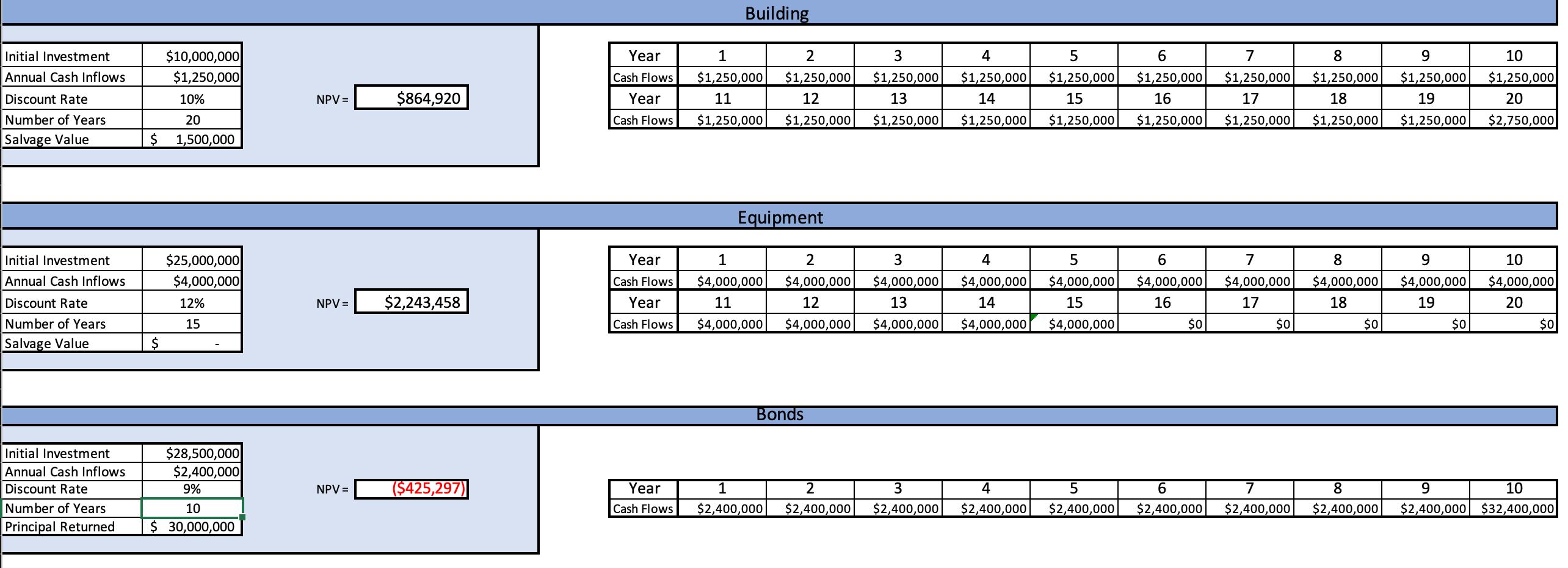Answered step by step
Verified Expert Solution
Question
1 Approved Answer
Hello! I have an idea of what is being asked but want to make sure I am making the right suggestions. I attached the assumptions
Hello!
I have an idea of what is being asked but want to make sure I am making the right suggestions. I attached the assumptions and the picture of the NPV for each investment. Thank you.
- 1. Financial Evaluation: In this section of the report, you will determine which of the three available investments are good financing options and describe the business's likely future financial performance.
- 2. Bond Investment: Determine if the bond investment is a good financing option for the business's financial health. Use your financial analysis and other financial information to support your claims.
- 3. Capital Equipment: Determine if the capital equipment investment is a good financing option for the business's financial health. Use your financial analysis and other financial information to support your claims.
- 4. Building: Determine if the building investment is a good financing option for the business's financial health. Use your financial analysis and other financial information to support your claims.

Image transcription text
FIN 320 Project Two Financial Assumptions When a business needs to invest, it's important to look at financial options. This is true for simple purchases, such as a new piece of equipment. And it is true for complex purchases, such as a new business. Business leaders must estimate cash flows from an investment and use the net present value (N PV) method to figure out if the investment is worthwhile. Financial Option 1: Purchase a $10 Million Building Rationale for investment: The business is considering environmental, social, and corporate governance (ESG) factors as part of its investment in a new building for its headquarters. The building itself will be a Leadership in Energy and Environmental Design (LEEDl-certified building. However, the new site currently has a large, inactive gas station that sold both gasoline and diesel fuel. The new site also has a large repair facility that was used for deliveries and tractor-trailer trucks for more than 50 years. Some restoration was performed on the site, but the previous owner ran out of funds before they could bring the site up to LEED standards. Four large fuel tanks remain on the site, and they will also need to be addressed per LEED standards. Assumptions to consider: I $10 million cash purchase I Building generates additional net profits after tax of $1.25 million per year I 20 year expected useful life of building I Salvage value: $1.5 million I Discount rate is 10% Financial Option 2: Lease of $25 Million in Equipment Rationale for investment: The business's current equipment is efficient, but it uses a lot of electricity. The production line also creates significant waste material, including waste plastics. The business is looking into leasing newer, more environmentally friendly equipment that will still allow it to be at least as efficient in production as it is now. Assumptions to consider: I Annual cash flows generated with equipment: 54 million I Discount rate is 12% II 15-year useful life I No salvage value Financial Option 3: $30 Million Investment in Bonds Rationale for investment: The business is offering these bonds for sale contracts with another business in China to assemble computer parts. The Chinese business has used child labor in the past, but it claims it has stopped this practice. However, the U.S. business selling these bonds has not investigated to verify whether these claims are true.
Image transcription text
Assumptions to consider: - 10-year bond 0 8% coupon - Priced at a discount: $95 0 Discount rate is 9%
Image transcription text
Building Initial Investment $10,000,000 Year 1 2 3 4 5 6 7 9 10 Annual Cash Inflows $1,250,000 Cash Flows $1,250,000 $1,250,000 $1,250,000 $1,250,000 $1,250,000 $1,250,000 $1,250,000 $1,250,000 $1,250,000 $1,250,000 Discount Rate 10% NPV = $864,920 Year 11 12 13 14 15 16 17 18 19 20 Number of Years 20 Cash Flows $1,250,000 $1,250,000 $1,250,000 $1,250,000 $1,250,000 $1,250,000 $1,250,000 $1,250,000 $1,250,000 $2,750,000 Salvage Value $ 1,500,000 Equipment Initial Investment $25,000,000 Year 1 2 3 4 5 6 7 8 9 10 Annual Cash Inflows $4,000,000 Cash Flows $4,000,000 $4,000,000 $4,000,000 $4,000,000 $4,000,000 $4,000,000 $4,000,000 $4,000,000 $4,000,000 $4,000,000 Discount Rate 12% NPV = $2,243,458 Year 1 12 13 14 15 16 17 18 19 20 Number of Years 15 Cash Flows $4,000,000 $4,000,000 $4,000,000 $4,000,000 $4,000,000 so $o so $0 so Salvage Value $ Bonds Initial Investment $28,500,000 Annual Cash Inflows $2,400,000 Discount Rate 9% NPV = ($425,297) Year 2 3 4 5 6 8 9 10 Number of Years LO Cash Flows $2,400,000 $2,400,000 $2,400,000 $2,400,000 $2,400,000 $2,400,000 $2,400,000 $2,400,000 $2,400,000 $32,400,000 Principal Returned $ 30,000,000FIN 320 Project Two Financial Assumptions When a business needs to invest, it's important to look at financial options. This is true for simple purchases, such as a new piece of equipment. And it is true for complex purchases, such as a new business. Business leaders must estimate cash flows from an investment and use the net present value (NPV) method to figure out if the investment is worthwhile. Financial Option 1: Purchase a $10 Million Building Rationale for investment: The business is considering environmental, social, and corporate governance (ESG) factors as part of its investment in a new building for its headquarters. The building itself will be a Leadership in Energy and Environmental Design (LEED)-certified building. However, the new site currently has a large, inactive gas station that sold both gasoline and diesel fuel. The new site also has a large repair facility that was used for deliveries and tractor-trailer trucks for more than 50 years. Some restoration was performed on the site, but the previous owner ran out of funds before they could bring the site up to LEED standards. Four large fuel tanks remain on the site, and they will also need to be addressed per LEED standards. Assumptions to consider: $10 million cash purchase Building generates additional net profits after tax of $1.25 million per year 20 year expected useful life of building Salvage value: $1.5 million Discount rate is 10% Financial Option 2: Lease of $25 Million in Equipment Rationale for investment: The business's current equipment is efficient, but it uses a lot of electricity. The production line also creates significant waste material, including waste plastics. The business is looking into leasing newer, more environmentally friendly equipment that will still allow it to be at least as efficient in production as it is now. Assumptions to consider: Annual cash flows generated with equipment: $4 million Discount rate is 12% 15-year useful life No salvage value Financial Option 3: $30 Million Investment in Bonds Rationale for investment: The business is offering these bonds for sale contracts with another business in China to assemble computer parts. The Chinese business has used child labor in the past, but it claims it has stopped this practice. However, the U.S. business selling these bonds has not investigated to verify whether these claims are true.
Step by Step Solution
★★★★★
3.48 Rating (141 Votes )
There are 3 Steps involved in it
Step: 1
Financial Evaluation In this section you are tasked with determining which of the three available investments are good financing options for the busin...
Get Instant Access to Expert-Tailored Solutions
See step-by-step solutions with expert insights and AI powered tools for academic success
Step: 2

Step: 3

Ace Your Homework with AI
Get the answers you need in no time with our AI-driven, step-by-step assistance
Get Started


